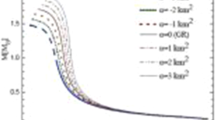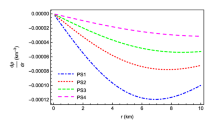Abstract
We model a compact radiant star that undergoes gravitational collapse from a certain initial static configuration until it becomes a black hole. The star consists of a fluid with anisotropy in pressures, bulk viscosity, in addition to the radial heat flow. A solution of Einstein’s field equations with temporal dependence was presented to study the dynamic evolution of physical quantities, such as the mass-energy function, the luminosity seen by an observer at infinity and the heat flow. We checked the acceptability conditions of the initial static configuration to obtain a range of mass-to-radius ratio in which the presented star model is physically reasonable. The energy conditions were analyzed for the dynamic case, in order to guarantee that the model is composed of a physically acceptable fluid within the range of the mass-to-radius ratio obtained for the static configuration or if they will be modified during the collapse.



















Similar content being viewed by others
Data Availability Statement
The authors declare that the data supporting the findings of this study are available within the article and its supplementary information files.
References
Chandrasekhar, A.: Phil. Mag. 11, 592–596 (1931)
Chandrasekhar, A.: Astron. J. 74, 81–82 (1931)
Lattimer, J.M.: Annual Review of Nuclear and Particle Science. 62, 485 (2012)
Oppenheimer, J. R., Volkoff, G. M.:Phys. Rev., 55 (1939), 374
Cameron, A.G.W.: Astron. J. 130, 884 (1959)
Oppenheimer , J. R., Snydder, H.: Phys. Rev., 56 (1939), 455
Penrose, R.: Riv. Nuovo Cim. 1, 252 (1967)
Penrose, R.: in Black holes and relativistic stars, ed. R. M. Wald, University of Chicago Press (1998)
Krolak, A.: Prog. Theor. Phys. Suppl. 136, 45 (1999). [arXiv:gr-qc/9910108 [gr-qc]]
Joshi, P. S.: Pramana 55, (2000) 529 [arXiv:gr-qc/0006101 [gr-qc]]
Celerier, M.N., Szekeres, P.: Phys. Rev. D 65, 123516 (2002). [arXiv:gr-qc/0203094 [gr-qc]]
Harada, T., Iguchi, H., Nakao, K. i.: Prog. Theor. Phys. 107, (2002) 449 [arXiv:gr-qc/0204008 [gr-qc]]
Brandt, C.F.C., Lin, L.M., Villas da Rocha, J.F., Wang, A.Z.: Int. J. Mod. Phys. D 11, 155 (2002). [arXiv:gr-qc/0105019 [gr-qc]]
Joshi, P.S., Dadhich, N., Maartens, R.: Phys. Rev. D 65, 101501 (2002)
Giambo, R., Giannoni, F., Magli, G., Piccione, P.: Commun. Math. Phys. 235, 545 (2003). [arXiv:gr-qc/0204030 [gr-qc]]
Chan, R., da Silva, M.F.A., Villas da Rocha, J.F.: Int. J. Mod. Phys. D 12, 347–368 (2003)
Brandt, C.F.C., Chan, R., da Silva, M.F.A., Villas da Rocha, J.F.: Int. J. Mod. Phys. D 19, 317 (2010)
Joshi, Pankaj S., Malafarina, Daniele: Int. J. Mod. Phys. D 20, 2641 (2011)
Malafarina, D., Joshi, P.S.: Int. J. of Mod. Phys. D 20, 463–495 (2011)
Sharma, R., Das, S.: Journal of Gravity, vol. 2013, (2013) Article ID 659605
Sheng-Xian Zhao, Shuang-Nan Zhang, Chinese Physics C, Vol. 42, Issue 8, article id. (2018) 5101
Hillebrondt, W., Steinnetz, K.O.: Astro. Astrophys. 53, 283 (1976)
Herrera, L., Ruggeri, G.J., Witten, L.: Astrophys. J. 234, 1094 (1979)
Cosenza, M., Herrera, L., Esculpi, M., Witten, L.: J. Math. Phys. 22, 118 (1981)
Chan, R., Herrera, L., Santos, N.O.: Mon. Not. R. Astron. Soc. 265, 533 (1993)
Herrera, L., Santos, N.O.: Phys. Rep. 286, 53 (1997)
Dev, K., Gleiser, M.: Gen. Relativ. Gravit. 35, 1435 (2003)
Estevez-Delgado, G., Estevez-Delgado, J.: Eur. Phys. J. C 78, 673 (2018)
Raychaudhuri, A.: Z. Astrophys. 43, 161 (1957)
Mohanlal, R., Maharaj, S.D., Tiwari, A.K., et al.: Gen Relativ Gravit 48, 87 (2016)
Mahomed, A.B., Maharaj, S.D., Narain, R.: AIP Advances 10, 035208 (2020)
Maharaj, S. D., Brassel, B. P.: The Eur. Phys. J. C volume 81, (2021) Article number: 783
Paliathanasis, A., Bogadi, R.S., Govender, M.: Eur. Phys. J. C 82, 987 (2022)
Leon, G., Govender, M., Paliathanasis, A.: Math. Meth. Appl. Sci. 45, 7728 (2022)
Reddy, P., Govender, M., Govender, W., Maharaj, S.D.: Annals of Physics 429, 16845 (2021)
Abbott, B.P., et al.: Astron. J. 12, 848 (2017)
Abbott, B.P.: et al., Phys. Rev. Lett., 119 (2017)
Abbott, B.P., et al.: ApJL. 896, 1–20 (2020)
Hernández, H., Núñez, L.A., Percoco, U.: Class. Quant. Grav. 16, 871–896 (1998)
Hernández, H., Núñez, L.A.: Can. J. Phys. 82, 29–51 (2002)
Vaidya, P.C.: Nature. 171, 260–261 (1953)
Israel, W.: Nouvo Cim. B. 44, 1–14 (1966)
Eisenhart, L. P.: Princeton University Press., (1949), 272
Nogueira, P.C., Chan, R.: Int. J. Mod. Phys. D. 13, 1727 (2004)
Cahill, M.E., McVittie, G.C.: J. Math. Phys. 11, 1382 (1970)
Lindquist, R.W., Schwartz, R.A., Misner, C.W.: Phys. Rev. 137, 1–14 (1965)
Wyman, M.: Phys. Rev. 75, 1930 (1949)
Tolman, R.C.: Phys. Rev. 55, 364–373 (1939)
Pretel, J.M.Z., da Silva, M.F.A.: Gen. Rel. and Grav. 51, 1–40 (2018)
Herrera, L., Denmat, G.L., Santos, N.O.: Gen Relativ Gravit 44, 1143 (2012)
Abebe, G.Z., Maharaj, S.D.: Pramana - J Phys 88, 19 (2017)
Hawking, S. W.; Ellis, G. F. R. (1973). The Large Scale Structure of Space-Time. Cambridge University Press. ISBN 0-521-09906-4
R. Chan, M. F. A. da Silva and Jaime F. Villas da Rocha, Mod. Phys. Lett. A 24, (2009) 1137
E. Böhm-Vitense, Cambridge University Press., (1989)
L. Rezzolla and O. Zanotti, Oxford University Press., (2013)
S. Chandrasekhar, An Introduction to the Study of Stellar Structure University of Chicago Press.,(1938)
Casali, R.H., Menezes, D.P., Braz, J.: J. Phys. 40, 166–171 (2010)
Moustakidis, C.C.: Gen. Relat. and Grav. 49, 1–17 (2017)
Esculpi, M., Alomá, E.: Eur. Phys. J. C. 67, 521–532 (2010)
Pretel, J.M.Z., da Silva, M.F.A.: Month. Not. Roy. Astron. Soc. 495, 1–12 (2020)
Kolassis, C.A., Santos, N.O., Tsoubelis, D.: Class. Quant. Grav. 5, 1329–1338 (1988)
Veneroni, L.S.M., da Silva, M.F.A.: Int. J. Mod. Phys. D. 28, 1–26 (2018)
Abbott, R., et al.: ApJL 915, L5 (2021)
R. Abbott et al, (2022) arXiv:2111.03634 [astro-ph.HE]
Acknowledgements
The financial assistance from Conselho Nacional de Desenvolvimento Científico (CNPq), Fundação Carlos Chagas Filho de Amparo à Pesquisa do Estado do Rio de Janeiro (FAPERJ), and Coordenação de Aperfeiçoamento de Pessoal de Nível Superior (CAPES) are gratefully acknowledged.
Author information
Authors and Affiliations
Contributions
Maria de Fátima Alves da Silva: as Arthur C. Mesquita’s master’s advisor, I proposed the research topic, suggested paths and participated in discussions and analyses. Arthur Câmara Mesquita: he developed all the calculations, built the graphs and participated in the discussions and analyses.
Corresponding author
Additional information
Publisher's Note
Springer Nature remains neutral with regard to jurisdictional claims in published maps and institutional affiliations.
Appendix: Junction condition
Appendix: Junction condition
The requirement of the matching between the inner (matter distribution) and outer (radiation zone around the distribution) solution across the \(\Sigma \) hipersurface is called as the junction condition problem. This condition imposes continuity of the first and second fundamental forms, the first being the metric and the second the extrinsic curvature, such as the conditions established by Israel [42]. So, when we approach \(\Sigma \) through interior or exterior spacetime we must demand that
where \(()_\Sigma \) means the value of () over \(\Sigma \). Thus, the equations when taken on the hypersurface \(\Sigma \) obtained from the inner and outer spacetimes are \(\chi _\pm ^\alpha =\chi _\pm ^\alpha (\xi ^i)\). The extrinsic curvature of \(\Sigma \) is given by [43]
where \(\eta ^\pm _\alpha \) are the components of the vector normal to \(\Sigma \) at coordinates \(\chi ^\alpha _\pm \). Consequently, the second continuity condition imposed on \(\Sigma \) takes the form
Following Nogueira and Chan [44], and considereing the metric given by (2), the continuity of the first fundamental form provides
On the other hand, the continuity of the second fundamental form leads us to obtain the mass-energy function in the form
which represents the total energy stored inside the hypersurface. This expression is equivalent to the one given by Cahill & McVittie [45].
In addition, we can take the gravitational redshift in the form
and we can see that this expression diverges when we do
The continuity of the extrinsic curvature also leads us to write the identity
Applying the equations (10) and (12) to the equality above we find [44]
which represents a generalization of the junction condition \((P_r)_\Sigma =0\) in the presence of heat dissipation and viscosities.
Finally, the total luminosity of the star received by an observer at rest at infinity, denoted by \(L_\infty \), is given by [46]
So, replacing (90), (93), (94) and (97) in (98) we can write
Rights and permissions
Springer Nature or its licensor (e.g. a society or other partner) holds exclusive rights to this article under a publishing agreement with the author(s) or other rightsholder(s); author self-archiving of the accepted manuscript version of this article is solely governed by the terms of such publishing agreement and applicable law.
About this article
Cite this article
Mesquita, A.C., da Silva, M.F.A. Radiant gravitational collapse with anisotropy in pressures and bulk viscosity. Gen Relativ Gravit 55, 58 (2023). https://doi.org/10.1007/s10714-023-03098-4
Received:
Accepted:
Published:
DOI: https://doi.org/10.1007/s10714-023-03098-4




